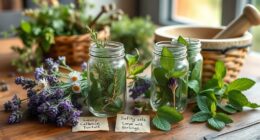To guarantee long-term survival through gardening and farming, focus on selecting a resilient site with good drainage, abundant sunlight, and reliable water access. Use organic soil amendments, crop rotation, and cover crops to maintain fertility. Choose diverse, nutrient-dense, and climate-adapted seeds, including heirlooms. Practice water-saving techniques and natural pest management methods. Incorporate season extenders and drought-tolerant crops to adapt to changing conditions. Continue exploring these strategies to build a truly resilient system.
Key Takeaways
- Prioritize soil health through organic amendments, crop rotation, cover crops, and seed saving to ensure sustained productivity.
- Select climate-adapted, resilient crop varieties, including heirlooms and drought-tolerant species, for higher yields and adaptability.
- Implement water-efficient irrigation, mulching, and rainwater harvesting to conserve resources and ensure reliable water access.
- Use organic pest, weed, and disease management techniques like companion planting and beneficial insects to maintain a resilient ecosystem.
- Incorporate season extenders, perennials, and diversified crops to prolong growing seasons and enhance long-term food security.
Planning Your Resilient Garden or Farm System
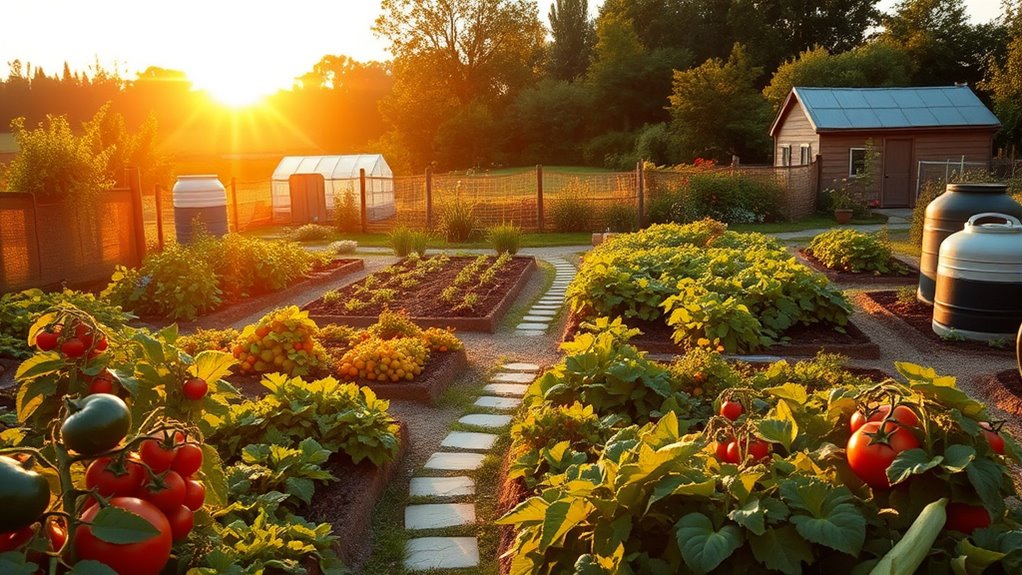
To build a resilient garden or farm system, start with thorough planning that considers your available space, sunlight, soil quality, and water access. A well-designed vegetable garden benefits from strategic crop rotation, which prevents soil depletion and pest buildup. Use heirloom seeds to guarantee genetic diversity and long-term sustainability, saving seeds for future seasons. Focus on maintaining soil fertility by regularly testing your soil and adding organic amendments, promoting healthy plant growth. Incorporate season extenders like cold frames or greenhouses to extend your growing season and maximize productivity. Ensuring reliable water access is essential for consistent watering and crop health. Additionally, understanding signs of spoilage in your stored produce helps prevent waste and ensures food safety. Developing a growth mindset can help you adapt to unforeseen challenges and continually improve your farming practices. Regularly monitoring your crops for early pest detection can greatly reduce damage and improve yields. Thoughtful planning at this stage lays the foundation for a resilient, productive farm system capable of thriving through changing conditions.
Selecting the Optimal Location and Site Features
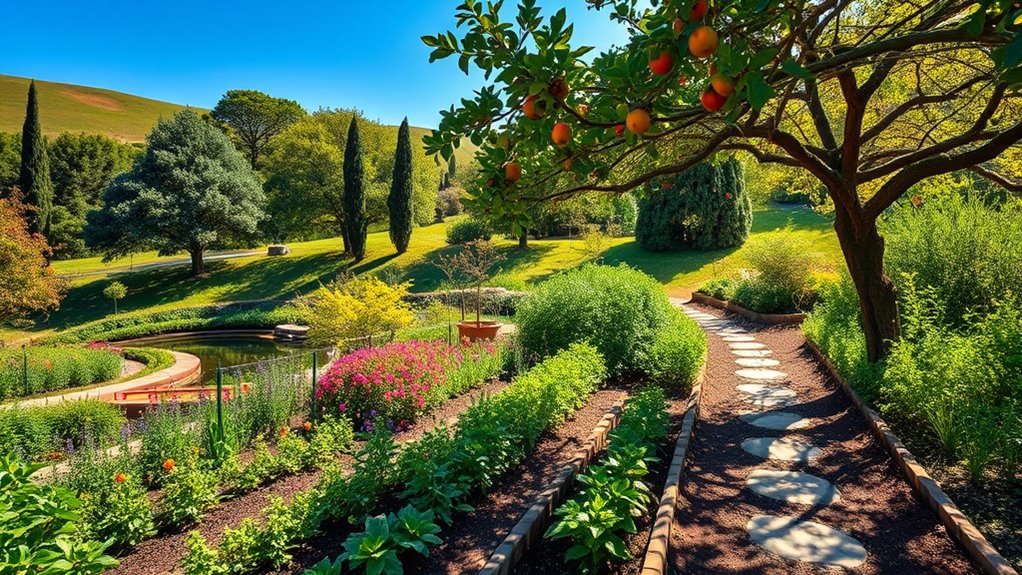
Selecting the best location for your garden or farm sets the foundation for a successful and resilient system. Choose a garden location that receives at least six hours of direct sunlight daily to promote healthy growth. Confirm reliable water access for consistent irrigation across seasons, preventing drought stress. Test your soil quality and amend it as needed to create a nutrient-rich environment tailored to your crops. Look for areas with good drainage to avoid waterlogging and root rot, and seek protection from strong winds that could damage plants. Proximity to your residence also matters, making maintenance and monitoring easier. Additionally, considering nearby water parks can offer insights into effective water management and recreational planning. By carefully considering sunlight, water access, soil quality, drainage, and protection, you set the stage for a productive, sustainable garden or farm that can endure over time.
Choosing Sustainable Seeds and Crop Varieties
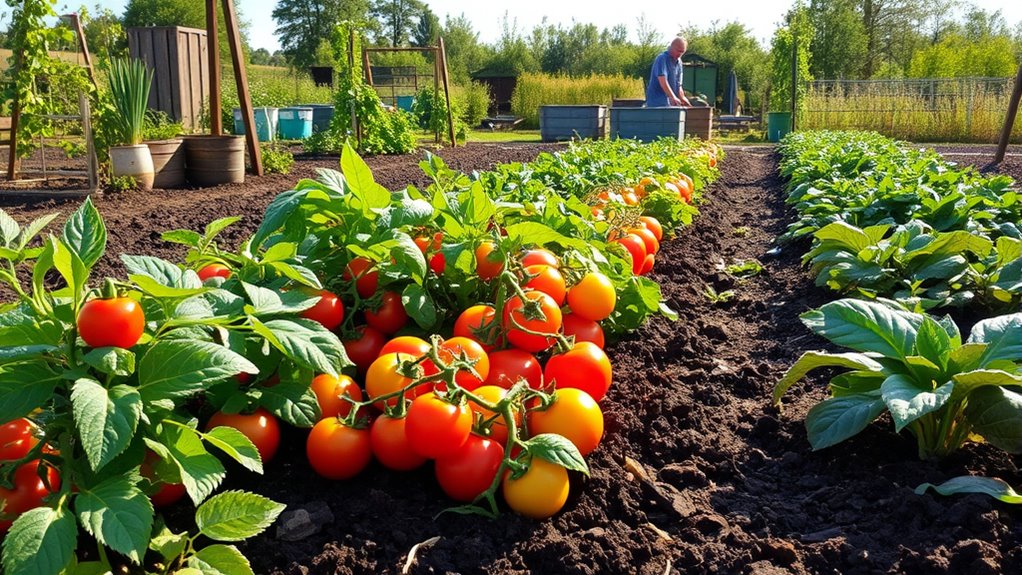
Choosing sustainable seeds and crop varieties is essential for building a resilient and productive garden. Start with heirloom seeds to guarantee seed saving, maintain genetic diversity, and promote long-term sustainability. Select climate-specific seed varieties to maximize your yield and adaptability to local conditions. Using seed vaults with diverse options can boost food security and protect against crop failure. Prioritize organic seeds to avoid GMOs and reduce chemical exposure, supporting environmentally friendly practices. Incorporate drought-tolerant and disease-resistant crops into your garden to increase resilience and reduce water and resource dependency over time. Additionally, investing in AI-driven security systems can help protect your garden’s infrastructure and resources from theft or vandalism. Incorporating biodiversity preservation strategies ensures a resilient ecosystem that can better withstand pests and environmental stresses. Seed diversity plays a crucial role in maintaining a healthy and adaptable garden environment. By choosing these sustainable options, you create a foundation for a self-sufficient garden that thrives in changing climates and preserves biodiversity for future generations. Furthermore, understanding the importance of soil health and practicing organic cultivation methods can lead to healthier plants and higher yields over the long term.
Designing a Diversified and Nutrient-Dense Crop Palette
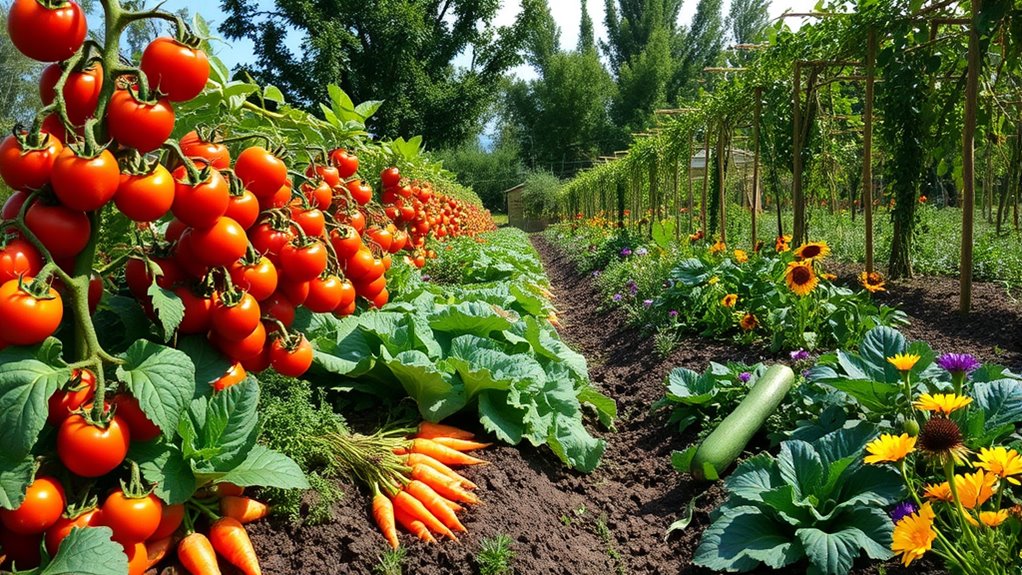
You can cultivate a resilient garden by selecting a variety of crops that provide essential nutrients and extend harvest seasons. Incorporating heirloom varieties and pollinator-friendly plants boosts diversity and supports ecosystem health. By balancing calorie-dense crops with vitamin-rich greens, you ensure a sustainable, nutrient-rich food supply year-round. Utilizing Vetted electric bike conversion kits can also facilitate transportation of produce and gardening supplies efficiently and sustainably.
Nutrient-Rich Crop Selection
A well-designed, nutrient-rich crop palette integrates a variety of vegetables and staples that support long-term health and resilience. Focus on nutrient-dense vegetables like kale, spinach, and broccoli, which provide essential vitamins and minerals. Include starchy staples such as potatoes, sweet potatoes, and corn to guarantee high-calorie reserves for energy needs. Choose heirloom varieties to enable seed saving, preserving genetic diversity and adaptability. Incorporate legumes like beans and lentils to boost soil nitrogen naturally and add plant-based protein. Prioritize crops with extended storage, including carrots, onions, and squash, to maintain year-round nutrition and reduce waste. Incorporating self watering plant pots can further enhance efficiency and sustainability in maintaining these crops. Utilizing natural materials in garden beds and structures can improve the overall health of the soil and plants. Implementing strategies that consider tax implications can help maximize net income and resource allocation. This balanced approach creates a resilient crop palette that sustains health and supports sustainable farming practices.
Diversity and Resilience Strategies
Creating a resilient and nutrient-dense crop palette starts with embracing diversity across plant types, including vegetables, grains, fruits, and herbs. This approach boosts resilience by reducing dependence on a single food source and lowering disease risk. Incorporate crop rotation and companion planting to maintain soil fertility, naturally control pests, and prevent soil depletion. Including perennials like fruit trees and berry bushes ensures a stable food supply over multiple seasons. Seed saving preserves genetic diversity and adaptability, especially for heirloom and regionally adapted varieties. Use the following strategies to optimize your garden:
| Strategy | Benefits |
|---|---|
| Crop Diversity | Reduces risk, enhances resilience |
| Crop Rotation | Maintains soil health, prevents pests |
| Companion Planting | Natural pest control, boosts growth |
| Seed Saving | Preserves genetics, ensures future resilience |
| Perennials | Long-term food sources, reduces replanting needs |
Additionally, selecting disease-resistant varieties can further strengthen your garden’s resilience against common pests and illnesses. Recognizing the importance of soil health is crucial for maintaining productive and sustainable gardens over time.
Implementing Organic Soil Management and Fertilization

To sustain healthy soil, you should incorporate organic amendments like compost, worm castings, and kelp meal, which naturally boost fertility. Regular soil testing helps you identify nutrient gaps and pH imbalances, guiding your organic fertilization efforts. Additionally, practicing crop rotation and planting cover crops like legumes improve soil structure, add nitrogen, and reduce erosion over time. Understanding soil testing methods can further optimize your soil management practices for long-term sustainability. Incorporating insights from agricultural automation can also help you monitor soil health more precisely and efficiently. Using soil sensors can provide real-time data on moisture and nutrient levels, enabling more targeted interventions. Maintaining a healthy soil ecosystem is essential for supporting diverse plant life and ensuring long-term agricultural productivity, especially when integrating precision agriculture techniques.
Organic Amendments and Composting
Implementing organic soil management and fertilization involves using amendments like compost, kelp meal, neem cake, and worm castings to naturally replenish nutrients, improve soil structure, and boost water retention. Composting transforms organic waste into nutrient-rich humus, supporting soil health and reducing chemical dependence. By adding organic amendments, you enhance microbial activity, which promotes healthy root growth and higher yields. To optimize your soil, consider:
- Regular testing to identify nutrient deficiencies
- Using compost and amendments to maintain balanced pH
- Incorporating diverse organic materials for sustained fertility
Soil health is foundational to creating a thriving garden ecosystem that supports long-term productivity. This approach fosters sustainable gardening by building resilient soil ecosystems, preventing degradation, and ensuring long-term productivity. Incorporating microbial activity through organic amendments further enhances nutrient cycling and plant health, making your garden more robust against pests and diseases. Emphasizing organic amendments and composting helps you create a thriving, self-sufficient garden that sustains your long-term survival goals.
Crop Rotation and Cover Crops
Incorporating crop rotation and cover crops into your gardening routine naturally enhances soil health by reducing nutrient depletion and breaking pest cycles. Crop rotation, which alternates plant families, prevents soil nutrient depletion and minimizes disease buildup, supporting organic gardening practices. Cover crops like clover, vetch, and rye fix atmospheric nitrogen, boost organic matter, and suppress weeds, promoting sustainable farming and improved soil fertility. Using organic fertilizers such as compost, manure, and kelp meal replenishes nutrients without chemicals, further enhancing soil structure. Including legumes in your crop rotation naturally increases nitrogen levels, decreasing reliance on synthetic fertilizers. Together, crop rotation and cover crops sustain soil health, ensuring your garden remains resilient, productive, and essential over the long term.
Water Conservation and Irrigation Strategies for Longevity
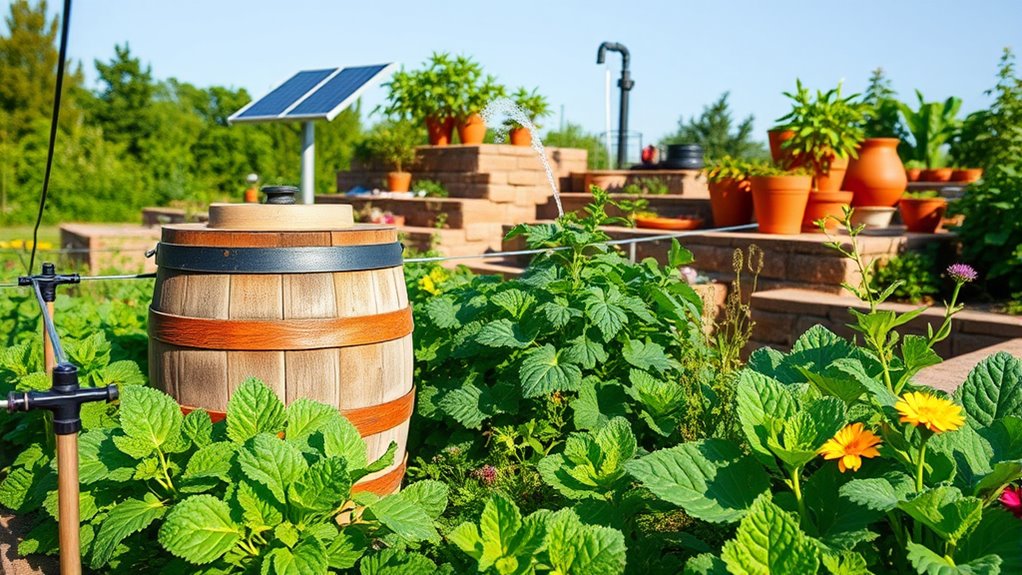
Water conservation is essential for ensuring your garden thrives over the long term, especially during dry spells. Implementing effective irrigation strategies can make a big difference. For example, drip irrigation delivers water directly to plant roots, conserving up to 90% more water than traditional sprinklers. Mulching helps reduce water evaporation from the soil surface by up to 70%, keeping moisture in the soil longer. Installing rainwater harvesting systems can supply 50-80% of your garden’s water needs, reducing dependence on municipal sources. Additionally, planting drought-tolerant crops like native herbs and certain vegetables minimizes water use. To optimize watering, use automated timers and soil moisture sensors to prevent waste and ensure consistent moisture levels. These strategies together promote long-term garden health and sustainability.
Managing Pests, Weeds, and Disease Naturally
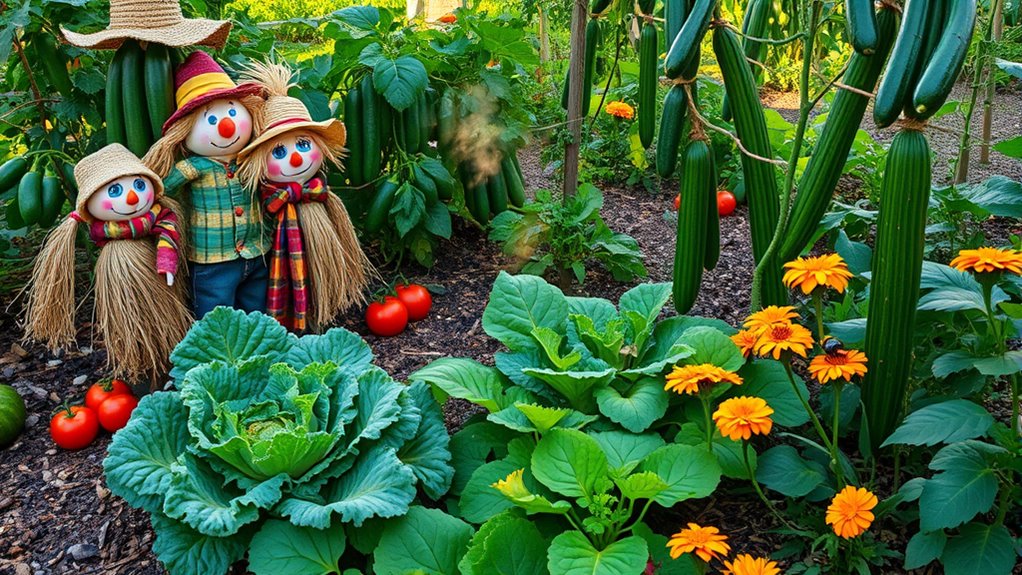
Managing pests, weeds, and disease naturally is a proactive way to keep your garden healthy without relying on chemicals. Effective pest control starts with organic gardening techniques like companion planting—plant marigolds with beans or basil with tomatoes—to repel pests and reduce disease risk. Introducing beneficial insects such as ladybugs and lacewings naturally controls pest populations. Physical barriers like row covers and insect netting prevent pests from reaching your crops and minimize disease spread. Crop rotation and plant diversification disrupt pest life cycles and help prevent soil-borne diseases. Organic remedies like neem oil, diatomaceous earth, and compost teas boost your plants’ defenses naturally. By combining these methods, you create a resilient garden that stays healthy without synthetic chemicals, promoting long-term sustainability and productivity.
Harvesting, Preserving, and Storing Food for Long-Term Use

After successfully growing and protecting your garden from pests and diseases, the next step is to guarantee your harvest lasts. Proper harvesting ensures you pick crops at peak ripeness for maximum flavor, nutrition, and storability. Preserving methods like canning, freezing, dehydration, and fermenting extend your food’s shelf life from months to over a year. For root vegetables such as potatoes, carrots, and onions, storing in root cellars or cool, dark places keeps them fresh through winter. To maintain food security, focus on:
- Harvesting at peak ripeness
- Preserving through canning, freezing, or fermenting
- Storing in airtight containers or cool environments
These techniques help you secure long-term storage and enjoy your garden bounty well beyond the growing season.
Ensuring Sustainability and Adaptability in Changing Conditions
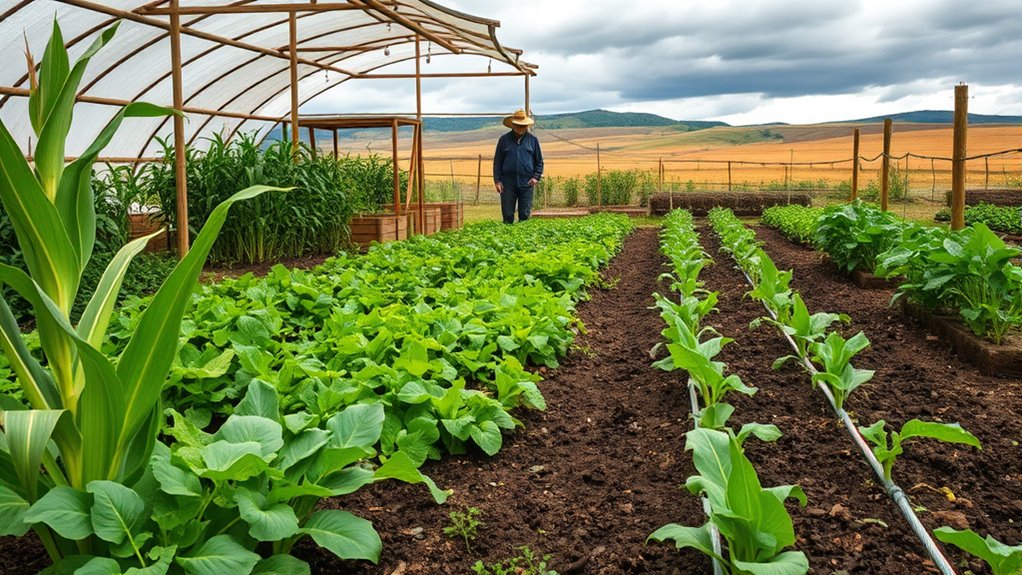
To guarantee your garden remains productive amid changing conditions, it’s essential to adopt sustainable practices that enhance resilience and adaptability. Focus on sustainable gardening by practicing crop rotation to prevent soil depletion and maintain soil fertility. Incorporate perennial crops and heirloom seeds to boost genetic diversity and long-term stability. Use water conservation techniques like drip irrigation and drought-tolerant crops to ensure reliable yields during droughts. Adding season extenders such as greenhouses and cold frames allows year-round gardening, adapting to climate shifts. Prioritizing these strategies helps your garden withstand environmental changes and thrive over time.
| Resilience Strategies | Benefits | Emotional Impact |
|---|---|---|
| Crop Rotation | Healthier soil, fewer pests | Confidence in harvest |
| Perennial Crops | Long-term productivity | Peace of mind |
| Water Conservation | Saves resources | Sustainable pride |
| Season Extenders | Year-round growth | Hope for every season |
| Soil Fertility | Richer, more resilient soil | Trust in your land |
Frequently Asked Questions
What Is the Gardening 3 Year Rule?
The gardening 3-year rule guides you to rotate crops and avoid planting the same varieties in the same spot for three years. This helps keep your soil healthy, prevents pests and diseases from taking hold, and promotes better yields. By diversifying your plantings and replacing nutrient-depleting crops with nitrogen-fixing ones, you guarantee your garden stays productive and sustainable over the long term.
What Is the Best Crop to Grow for Survival?
You wanna know the best crop for survival? Focus on root vegetables like carrots, potatoes, and beets. They pack a lot of calories, store well, and grow easily. Legumes such as beans and lentils are also key because they provide protein and fix nitrogen in the soil. These crops are dependable, nutritious, and efficient, making them ideal choices to guarantee your long-term food security in any situation.
Does Gardening Increase Your Life Span?
You might say gardening is a win-win situation for your health. It definitely can increase your lifespan by keeping you active, reducing stress, and promoting mental well-being. Growing your own fresh produce boosts your immune system, and the social aspect keeps you engaged. So, if you want to add years to your life, digging in the dirt regularly is a smart move that pays off in the long run.
Can You Actually Save Money Gardening?
Yes, you can save money gardening. By growing your own vegetables, you cut grocery bills considerably, saving up to $600 annually. Your initial investment in seeds and tools pays off quickly, and you reduce reliance on store-bought produce and processed foods. Plus, saving seeds from heirloom plants helps lower future costs. With proper planning and crop choices, you guarantee a steady, affordable supply of nutritious produce that offsets your shopping expenses.
Conclusion
By following these sustainable practices, you can create a resilient garden or farm that endures for years. Imagine turning your backyard into a thriving food source, just like Sarah did, who diversified her crops and adopted organic methods. With careful planning and adaptability, you’ll enjoy abundant harvests and a healthier environment. Start small, stay consistent, and watch your long-term food security blossom, ensuring you and your family thrive for generations to come.










